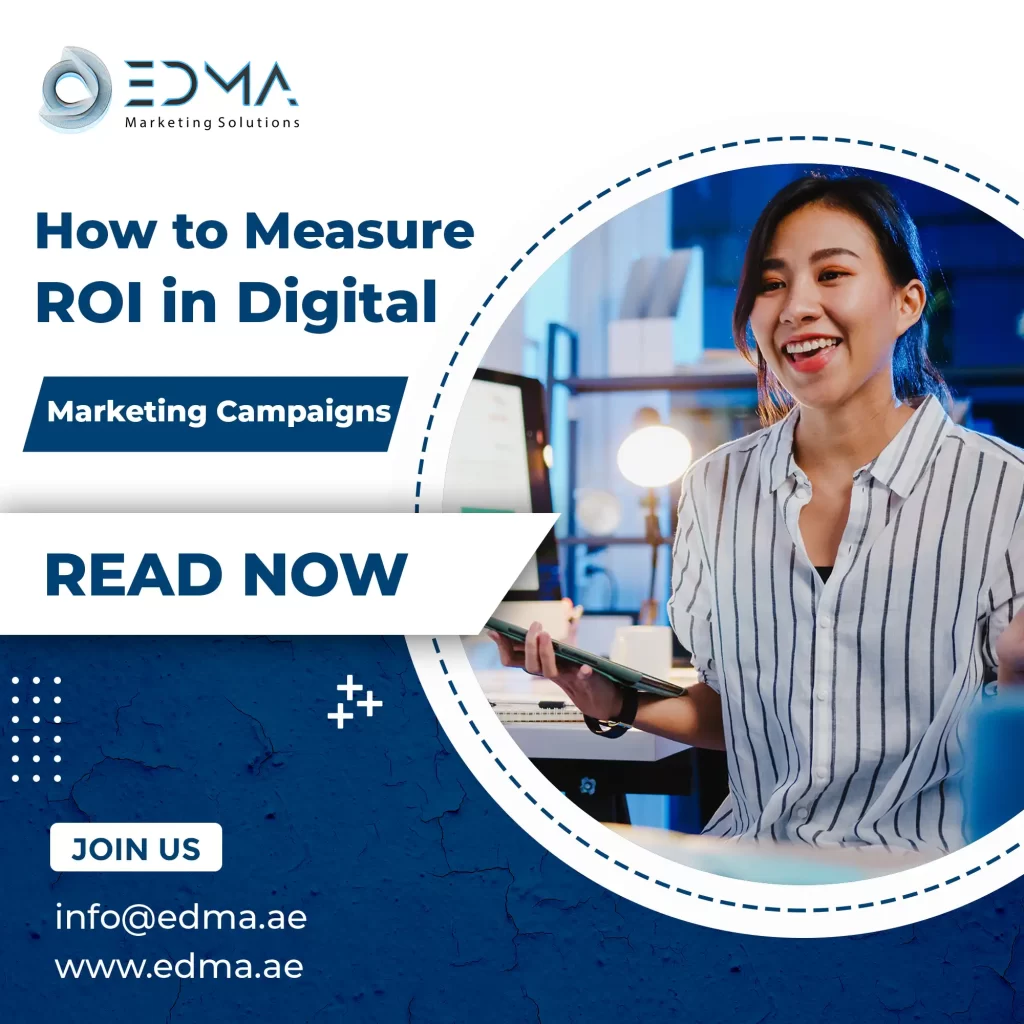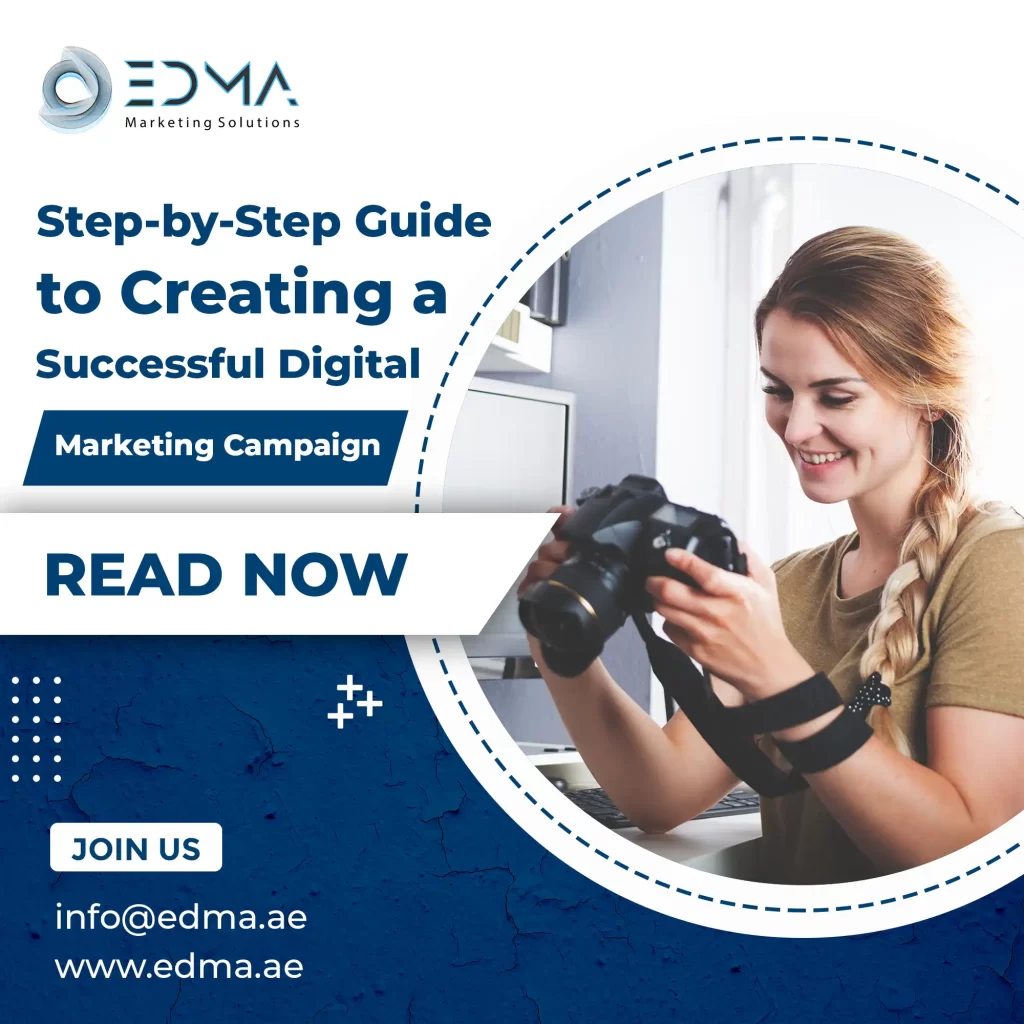How to Measure ROI in Digital Marketing Campaigns

H1: How to Measure ROI in Digital Marketing Campaigns Furthermore Measuring Return on Investment (ROI) in digital marketing is crucial for understanding the effectiveness of your campaigns and optimizing your strategies for maximum results. ROI helps determine Moreover whether your marketing efforts are delivering value relative to their costs, and it is one of the key metrics used by marketers to assess success. In this article, we will explore how to measure ROI in digital In addition marketing campaigns, the key metrics to track, and how to use this data to improve future marketing efforts. Define Your Campaign Goals As well as The first step in measuring ROI is defining clear campaign goals. Without specific goals, it’s impossible to determine whether your marketing efforts are successful. Goals should be SMART—Specific, Plus Measurable, Achievable, Relevant, and Time-bound. Examples of Goals: However Increase website traffic by 25% over three months. On the other hand Generate 100 new leads from Facebook Ads in one month. Nonetheless Achieve a 5% conversion rate on a new product launch page. Digital Marketing Defining your campaign’s objectives will help you measure the ROI against these predetermined targets. Conversely Calculate the Total Investment in Your Campaign Whereas ROI measurement starts with understanding the total investment involved in running your campaign. The investment includes all costs related to the campaign, such as: Advertising Costs: Paid ads (Google Ads, Facebook Ads, LinkedIn Ads, etc.) Content Creation: Budget for creating videos, blog posts, graphics, etc. Software and Tools: Email marketing platforms, analytics tools, design software, etc. Labor Costs: Salaries or fees for marketers, content creators, designers, or consultants. Therefore Sum up all the direct and indirect expenses to get the total investment of the campaign. Digital Marketing Track the Revenue Generated from the Campaign The next step in measuring ROI is tracking the revenue or value generated from the campaign. This is where tracking conversions is essential. Some of the key conversion metrics to consider are: Sales Revenue: The total revenue generated from customers who came through the campaign. Leads: If your goal was to generate leads, track the number of qualified leads that have a high probability of converting. Customer Lifetime Value (CLTV): For long-term campaigns, track the average value of each customer over their entire relationship with your brand. Use tools like Google Analytics, CRM systems, or sales tracking software to track the performance and identify how much revenue was generated from each touchpoint of the campaign. Calculate Your ROI Digital Marketing Once you have defined your goals, tracked the investment, and monitored the revenue, it’s time to calculate your ROI. Because of this The formula for calculating ROI is: ROI=Revenue−Cost of CampaignCost of Campaign×100\text{ROI} = \frac{\text{Revenue} – \text{Cost of Campaign}}{\text{Cost of Campaign}} \times 100ROI=Cost of CampaignRevenue−Cost of Campaign×100 For example, if your campaign generated $10,000 in revenue and cost $2,000, your ROI would be: ROI=10,000−2,0002,000×100=400%\text{ROI} = \frac{10,000 – 2,000}{2,000} \times 100 = 400\%ROI=2,00010,000−2,000×100=400% This means for every dollar spent on the campaign, you generated $4 in revenue. Analyze the Data and Optimize for Future Campaigns Once you’ve calculated your ROI, it’s time to dive into the data to identify what worked and what didn’t. Analyze metrics like click-through rate (CTR), cost per click (CPC), conversion rates, and customer acquisition cost (CAC) to identify the most profitable channels and tactics. A/B Testing: Continuously A/B test different elements of your campaign (ad copy, landing pages, targeting) to find the most effective strategy. Optimize: Adjust your budget and resource allocation to invest more in high-performing areas while reducing spend on underperforming channels. Conclusion: Use ROI to Drive Continuous Improvement As a result Measuring ROI in digital marketing campaigns helps marketers determine the effectiveness of their strategies, optimize budgets, and improve overall performance. By clearly defining goals, tracking revenue, calculating ROI, and making data-driven decisions, you can continually refine your campaigns to deliver better results. Feel Free Contact us today to learn more and elevate your digital marketing efforts!
Mobile Apps Digital Marketing

How Mobile Apps Can Enhance Your Digital Marketing Strategies Mobile apps have become a critical part of the digital marketing ecosystem. With millions of people using smartphones daily, apps offer businesses a direct channel to engage with customers, enhance brand Furthermore loyalty, and drive conversions. In this article, we’ll explore how mobile apps can enhance your digital marketing strategies and help you achieve your business objectives. Direct Communication with Customers Mobile apps provide a unique advantage in terms of direct communication with your customers. Through push notifications and in-app messaging, businesses can deliver timely and personalized messages directly to users’ devices. Push Notifications: Push notifications are an effective way to alert customers about new offers, updates, or reminders. By sending relevant messages, you can encourage users to return to your app and engage with your brand. In-App Messaging: Use in-app messaging to provide customers with a seamless experience within the app. Whether it’s a welcome message, promotional offer, or customer support, in-app messaging creates a personalized user experience. Improve Customer Engagement In addition Mobile apps provide an engaging platform for customers to interact with your brand. Features like gamification, loyalty programs. Moreover social sharing options can help increase customer engagement and build long-term relationships. Loyalty Programs: Reward loyal customers with exclusive offers or points that can be redeemed for discounts or products. Mobile apps make it easy for customers to track their progress and redeem rewards. Gamification: Incorporating gamification elements, such as challenges, badges, and rewards, into your app can increase user engagement and encourage repeat usage. Enhance Personalization As well as Mobile apps allow you to personalize the user experience, providing customers with tailored content, recommendations, and offers based on their preferences, location, and behavior. Personalized Recommendations: Use data analytics to suggest products or content based on users’ past behavior. For example, an e-commerce app can recommend products based on previous purchases or browsing history. Geolocation Targeting: Mobile apps can leverage geolocation to send personalized offers when users are near your physical store or relevant locations, increasing the likelihood of conversion. Capture Customer Data However Mobile apps provide businesses with valuable data about their customers’ behavior, preferences. Plus usage patterns. This data can be used to refine marketing strategies and enhance the overall user experience. User Insights: Analyze app usage data to understand which features are most popular and where users drop off. Use this information to improve the app experience and refine your digital marketing campaigns. Customer Feedback: Mobile apps can also include feedback mechanisms, such as surveys or rating systems, to gather insights directly from users. Facilitate Seamless Purchases On the other hand Mobile apps can streamline the purchasing process, providing customers with an easy way to buy products or services directly through the app. In-App Purchases: Enable customers to purchase products or services without leaving the app. By simplifying the checkout process, you can improve conversion rates and reduce friction for users. One-Click Payments: Offer payment options such as one-click payments, which make it easier for customers to complete purchases with minimal effort. Conclusion: Mobile Apps as a Powerful Marketing Tool Conversely Mobile apps are a powerful tool for enhancing your digital marketing strategies. By facilitating direct communication, improving engagement, enabling personalization, capturing customer data, and Whereas streamlining the purchasing process, mobile apps help businesses build stronger relationships with customers and boost conversions. Feel Free Contact us today to learn more and elevate your digital marketing efforts!
Target Audience Social Media

How to Target Your Audience Precisely with Social Media Marketing Furthermore Social media marketing offers businesses an unprecedented opportunity to reach and engage with their audience. With the vast amount of data available on social platforms, businesses can target their audience with precision. In this article, we’ll explore how to target your audience effectively on social media to drive engagement, boost brand awareness, and increase conversions. Define Your Ideal Customer Before you can effectively target your audience, you need to define who they are. This involves understanding your customer’s demographics, interests, behaviors, and online habits. Create Buyer Personas: Develop detailed buyer personas that represent your ideal customers. This includes age, gender, location, interests, and challenges. Moreover detailed your personas are, the more accurately you can target them on social media. Segment Your Audience: Break down your audience into different segments based on factors such as interests, behaviors, and location. For instance, you might have different segments for first-time In addition buyers, returning customers, or people interested in specific products or services. Leverage Social Media Targeting Tools Also Most social media platforms provide advanced targeting features that allow you to reach specific groups of people based on a variety of criteria. Facebook Ads Manager: Facebook’s Ads Manager lets you target users based on demographics, location, interests, behaviors, and more. It also allows for custom audience targeting, where you can upload customer lists to target people who have already interacted with your business. Instagram and TikTok: Both Instagram and TikTok allow for advanced targeting based on similar parameters as Facebook. You can create highly engaging ads with visuals tailored to specific audience segments. LinkedIn Ads: If you’re targeting a B2B audience, LinkedIn is an excellent platform. You can target professionals based on job title, company size, industry, and even specific skills. Use Content That Resonates with Your Audience The content you create plays a major role in attracting the right audience. To target your audience effectively, you need to develop content that speaks to their interests and needs. Create Audience-Centric Content: Tailor your content to address the specific challenges, pain points, or desires of your audience. Whether you’re posting educational content, product demos, or behind-the-scenes footage, it should speak directly to what your audience cares about. Utilize Visuals and Stories: Social media is a visual platform, so incorporate eye-catching visuals such as infographics, videos, and images. Stories and live videos are also highly engaging formats that help build a stronger connection with your audience. H2: 4. Retarget Visitors Who Have Already Interacted with Your Brand Retargeting is a powerful way to re-engage users who have already shown interest in your brand. Whether they visited your website or interacted with your social media content, retargeting ads can remind them of your offerings and encourage them to take action. Facebook Pixel: Use Facebook’s pixel to track visitors to your website and create custom audiences for retargeting. This allows you to show ads to people who have already engaged with your brand but haven’t yet converted. Instagram Retargeting: Similarly, Instagram ads can be used to retarget users who interacted with your posts or visited your profile, keeping your brand top-of-mind. Analyze and Optimize Your Social Media Targeting Even with the right tools and strategies, social media marketing requires constant monitoring and optimization to ensure effectiveness. Monitor Analytics: Use platform-specific analytics to track the performance of your posts, ads, and campaigns. Look at metrics like reach, engagement, click-through rate (CTR), and conversion rate to determine which content and targeting strategies are most effective. A/B Testing: Run A/B tests to compare different targeting parameters and ad creatives. For example, test different age groups, locations, or interests to find the most responsive audience. Conclusion: Precision Targeting for Social Media Success Effective audience targeting is one of the key factors in successful social media marketing. By defining your audience, leveraging social media targeting tools, creating resonant content, retargeting interested users, and continuously optimizing your strategy, you can significantly improve your social media marketing efforts and drive better results for your business. Feel Free Contact us today to learn more and elevate your digital marketing efforts!
Creating a Successful Digital Marketing Campaign

Step-by-Step Guide to Creating a Successful Digital Marketing Campaign Furthermore In today’s competitive digital landscape, crafting a well-planned digital marketing campaign is crucial for achieving business growth. With numerous channels available, such as social media, email Moreover marketing, SEO, and paid advertising, businesses need a clear strategy to ensure their marketing efforts are cohesive and effective. This step-by-step guide will walk you through the process of creating a In addition digital marketing campaign that delivers measurable results. Define Your Campaign Goals Also Before launching any campaign, it’s essential to define clear, measurable goals. What do you want to achieve? Whether your goal is to increase website traffic, generate leads, boost brand awareness, or drive As well as conversions, knowing your objectives will guide the entire campaign strategy. SMART Goals: Ensure your goals are Specific, Measurable, Achievable, Relevant, and Time-bound (SMART). KPIs: Define Key Performance Indicators (KPIs) that align with your goals. Common KPIs include conversion rates, cost per lead (CPL), customer acquisition cost (CAC), and return on investment (ROI). Understand Your Target Audience Guide to Creating a Successful Digital Marketing Understanding your target audience is the foundation of any successful marketing campaign. However By knowing who you’re marketing to, you can tailor your message, choose the right platforms, and create content that resonates with your audience. Develop Buyer Personas: Create detailed buyer personas that represent your ideal customers. Include demographic information such as age, gender, location, interests, pain points, and buying behavior. On the other hand This helps you create more targeted campaigns. Conduct Market Research: Analyze industry trends, competitor strategies, and customer behavior to identify opportunities for differentiation and ensure your campaign stands out. Choose the Right Digital Channels Guide to Creating a Successful Digital Marketing There are various digital marketing channels you can leverage in your campaign, such as email marketing, social media platforms, search engine optimization (SEO), content marketing, and paid advertising. Each channel serves a unique purpose, so it’s essential to choose the ones that align with your campaign goals and audience preferences. Social Media: If your audience is active on social platforms, consider using Facebook, Instagram, LinkedIn, Twitter, or TikTok. Tailor your content to each platform to increase engagement. SEO & Content Marketing: If driving organic traffic to your website is a goal, focus on creating valuable, SEO-optimized content that answers your audience’s questions. Paid Advertising: Google Ads, Facebook Ads, and other paid media options allow you to target specific demographics with paid campaigns that deliver immediate results. Develop a Compelling Message A clear and compelling message is essential for capturing your audience’s attention. Your message should align with your campaign goals and resonate with the needs, pain points, and desires of your audience. Value Proposition: Highlight the unique value your product or service offers. What sets you apart from competitors? Why should your audience choose you over others? Create Engaging Content: Whether it’s blog posts, videos, infographics, or ads, ensure your content is engaging, informative, and visually appealing. Use storytelling to create an emotional connection with your audience. Set a Budget and Allocate Resources It’s essential to set a budget and allocate resources Nonetheless effectively to maximize the return on investment (ROI). Budget Allocation: Divide your budget across different channels based on where your target audience spends their time. For example, allocate more funds to social media if your audience is primarily on Instagram and Facebook. Resource Planning: Consider the resources needed for the campaign, such as content creation, graphic design, copywriting, and campaign management. Make sure you have the right team and tools in place to execute your campaign successfully. Implement and Monitor Your Campaign Launch your ads, publish your content, and monitor performance But closely to make data-driven adjustments. Track Campaign Performance: Use tools like Google Analytics, social media insights, and email marketing analytics to monitor the performance of your campaign in real-time. Look at metrics like click-through rates (CTR), engagement rates, and conversion rates. A/B Testing: Run A/B tests to determine which elements of your campaign (e.g., ad copy, email subject lines, landing pages) resonate most with your audience. Make adjustments based on the results. Analyze and Optimize After your campaign has run for a while, it’s important to analyze its success and identify areas for improvement. This helps ensure future campaigns are even more effective. Measure ROI: Calculate the return on investment (ROI) by comparing the cost of the campaign with the revenue or value generated. This will help you understand if your campaign was successful. Optimize for Future Campaigns: Use insights from your analysis to optimize future campaigns. This could involve adjusting your messaging, budget allocation, or targeting strategy to achieve better results. Conclusion: Creating Effective Digital Marketing Campaigns Creating a successful digital marketing campaign requires careful planning, clear goals, an understanding of your audience, and the right channel choices. By following this step-by-step guide, you can build campaigns that resonate with your target audience, deliver measurable results, and help grow your business. Feel Free Contact us today to learn more and elevate your digital marketing efforts!
Website Design in Digital Marketing

The Importance of Website Design in Digital Marketing Strategies Furthermore Your website is the digital face of your brand and plays a crucial role in your digital marketing success. A well-designed website not only enhances user experience but also helps convert visitors into Moreover leads and customers. In this article, we’ll explore why website design is so important in digital marketing and how you can leverage design elements to improve your online presence and performance. First Impressions Matter In addition to When visitors land on your website, the first few seconds are critical. Studies show that users form judgments about your website in less than a second based on its design. A professional, visually Also appealing design creates a sense of trust and credibility, while a poorly designed site can drive visitors away. Professional Look: Ensure your website reflects your brand identity with consistent colors, fonts, and logos. A cohesive design helps establish trust and professionalism. Mobile-Friendly Design: With mobile internet usage surpassing desktop, it’s essential that your website is responsive and looks great on all devices. A mobile-optimized design ensures a seamless user experience, reducing bounce rates. User Experience (UX) and Conversion Rates As well as A website’s design plays a pivotal role in shaping user experience (UX). A seamless, intuitive design makes it easier for visitors to navigate your site, find what they’re looking for, and ultimately take action. Navigation: Simplify site navigation by organizing content logically and making important pages easy to find. Users should never feel lost or frustrated while navigating your website. Clear Calls to Action: A well-designed website clearly guides visitors to the next step, whether it’s making a purchase, signing up for a newsletter, or contacting your business. Use buttons with strong, action-oriented language like “Get Started,” “Buy Now,” or “Contact Us.” Fast Loading Times: Slow-loading websites increase bounce rates and negatively affect SEO. A fast, optimized site enhances UX and encourages visitors to stay longer. Website Design Affects SEO Plus On the other hand Website design and SEO go hand-in-hand. A well-structured website with optimized design elements can improve your search engine rankings and visibility, driving more organic traffic. Mobile Optimization: Google uses mobile-first indexing, meaning websites that are optimized for mobile devices are more likely to rank higher in search results. Site Architecture: Proper site architecture, such as having a clear URL structure and using proper header tags (H1, H2, H3), makes it easier for search engines to crawl and index your pages. Internal Linking: A well-designed website includes a strategic internal linking structure that helps search engines understand the relationships between pages and boosts SEO. Trust and Credibility Nonetheless Trust is a crucial factor in the digital buying process. A professional website design enhances your brand’s credibility, making visitors more likely to engage with your content and make purchases. Security Features: Display security badges and ensure your website uses HTTPS encryption. This assures visitors that their data is safe, especially when entering personal information or making purchases. Social Proof: Including testimonials, reviews, and case studies on your website helps build credibility and trust with potential customers. A well-designed testimonial section or review slider can showcase your reputation effectively. Visual Appeal Drives Engagement But The visual appeal of your website can significantly impact user engagement. Stunning design elements, combined with relevant images and graphics, can draw visitors in and keep them on your site longer. High-Quality Imagery: Use high-quality, relevant images that align with your brand and messaging. Avoid stock photos that feel inauthentic. Whitespace and Clean Layouts: A cluttered website overwhelms visitors and detracts from the user experience. A clean layout with ample whitespace makes your content easy to digest and guides users to key areas of your site. Visual Hierarchy: Use visual hierarchy to highlight important information and guide visitors’ eyes to critical elements such as CTAs, offers, and key messages. Track Performance and Iterate Conversely Once your website is live, it’s important to track its performance and make design improvements based on data. Regularly test and tweak your design to improve conversion rates and user satisfaction. Therefore Use Analytics Tools: Tools like Google Analytics can help you track visitor behavior, identify drop-off points, and monitor the performance of different pages. As a result A/B Testing: Conduct A/B tests on key design elements, such as CTAs, images, or page layouts, to see what resonates best with your audience. Conclusion: A Well-Designed Website Drives Digital Marketing Success Consequently In today’s digital world, your website is often the first point of contact between your brand and potential customers. A well-designed website enhances user experience, improves SEO, builds trust, and boosts conversions. By focusing on clean design, mobile optimization, and user-centered strategies, you can create a website that serves as a powerful tool in your digital marketing strategy. Feel Free Contact us today to learn more and elevate your digital marketing efforts!
How to Write Articles That Attract Customers

Content Marketing: How to Write Articles That Attract Customers Content marketing is one of the most powerful strategies for attracting and retaining customers. By creating valuable, informative, and engaging articles, businesses Furthermore can establish authority, build trust, and ultimately drive sales. In this article, we’ll explore key strategies for writing articles that not only attract Moreover customers but also engage them and lead to conversions. Understand Your Audience Also to Write Articles That Attract Customers The foundation of any successful content marketing strategy is understanding your audience. Knowing their pain points, desires, and interests will help you Attract Customers As well as craft content that resonates with them and meets their needs. Create Buyer Personas: Develop detailed buyer personas that represent different segments of your audience. Plus These personas should include demographics, interests, challenges, and goals, which will guide your content creation. Research Keywords: Use tools like Google Keyword Planner, SEMrush, or Ahrefs to discover what your audience is searching for. However Targeting the right keywords ensures your articles appear in front of the right people at the right time. Craft Compelling Headlines to Write Articles That Attract Customers Whereas The headline of your article is the first thing readers see, so it needs to capture attention and entice them to click. A well-crafted headline can make a huge Therefore difference in the success of your content. Use Numbers and Lists: Headlines that promise specific results, like “5 Tips for…,” or “How to Solve X Problem,” tend to perform well because they offer clear value. Create Curiosity: Headlines that spark curiosity or promise to reveal a solution to a problem can significantly increase click-through rates. For example, “The One Thing You’re Doing Wrong with Content Marketing” creates intrigue. Focus on Value-Driven Content On the other hand Write Articles The primary goal of content marketing is to provide value. Articles that offer practical, actionable advice are more likely to attract customers and earn their trust. Solve Problems: Address common problems your audience faces and provide clear, actionable solutions. Nonetheless This positions your business as a trusted authority in your industry. Educate and Inform: Instead of just promoting your products or services, focus on educating your audience. But Share insights, tips, case studies, and industry trends that help them achieve their goals. Incorporate Visuals: Use images, infographics, and videos to complement your content and make it more engaging. Conversely Visual content is not only easier to digest but also shares more effectively on social media. Optimize for SEO As a result No matter how great your content is, it won’t attract customers if it doesn’t appear in search results. To maximize the visibility of your articles, you need to optimize them for SEO. Keyword Optimization: Incorporate your target keywords naturally throughout the article, including in the headline, subheadings, and body text. However, Consequently avoid keyword stuffing, as this can hurt readability and SEO performance. Use Internal and External Links: Link to other relevant articles on your website (internal links) and authoritative sources (external links). This helps Hence improve SEO and provides additional value to your readers. Optimize for Featured Snippets: Structure your content in a way that answers specific questions directly in the text. This increases the chances of your Because of this content being featured in Google’s “position zero.” Write Engaging, Readable Content Engagement is key to retaining readers and encouraging them to take action. To keep your audience hooked, your content needs to be engaging and easy to read. Use Short Paragraphs: Break your content into short, digestible paragraphs to avoid overwhelming readers. Large blocks of text can make articles appear intimidating. Use Clear, Simple Language: Avoid jargon and overly technical language unless your audience is familiar with it. Write in a conversational tone that makes readers feel like you’re speaking directly to them. Call to Action (CTA): Every article should include a clear call to action. Whether it’s encouraging readers to download a free guide, sign up for a newsletter, or purchase a product, guide them toward the next step. Promote Your Content Creating great content is just half the battle. To attract customers, you need to actively promote your articles. Social Media Sharing: Share your articles on social media platforms like Facebook, Twitter, LinkedIn, and Instagram. Tailor your posts to each platform’s audience and best practices. Email Marketing: Send your articles to your email list. Include a compelling subject line and a short summary to encourage readers to click through and read the full article. Guest Blogging and Backlinking: Write guest posts for other blogs in your industry and include backlinks to your articles. This increases your content’s reach and boosts its SEO performance. Conclusion: Drive Conversions with Quality Content To attract customers through content marketing, it’s essential to create articles that offer value, engage readers, and solve their problems. By understanding your audience, writing compelling headlines, optimizing for SEO, and promoting your content strategically, you can drive traffic to your website and turn readers into loyal customers Feel Free Contact us today to learn more and elevate your digital marketing efforts!
How Small Businesses Can Leverage Digital Marketing Effectively

How Small Businesses Can Leverage Digital Marketing Effectively Furthermore For small businesses, digital marketing offers a world of opportunities to reach a broader audience, increase brand visibility, and drive sales—all at a fraction of the cost of traditional marketing. The Moreover challenge lies in using digital marketing effectively to maximize resources and compete with larger companies. This article provides practical tips for small businesses to leverage digital marketing In addition to successfully and make a significant impact. Start with a Strong Online Presence Also Before diving into complex marketing campaigns, small businesses need to establish a solid online foundation. Meanwhile Having an attractive, functional website is the first step in building trust with potential customers. Specifically first Create a User-Friendly Website: A clean, professional, and easy-to-navigate website is crucial. Ensure that it’s mobile-friendly, loads quickly, and has clear calls-to-action (CTAs) that encourage visitors to make a purchase or contact you. second Optimize for SEO: Invest in basic SEO practices to help your website rank higher in search engine results. This includes using relevant keywords, optimizing your meta descriptions and titles, and regularly publishing valuable content. Utilize Social Media Marketing As well as Social media marketing offers small businesses a cost-effective way to connect with customers, build brand awareness, and promote products or services. Subsequently Platforms like Facebook, Instagram, LinkedIn, and Twitter offer powerful tools for targeting specific audiences. Consistent Posting: Regularly post valuable content that resonates with your audience. Whether it’s educational posts, product showcases, or behind-the-scenes glimpses, consistency builds credibility. Engage with Followers: Respond to comments, messages, and reviews to foster a sense of community. Social media isn’t just about broadcasting your brand; it’s about building relationships. Leverage Paid Advertising: Small businesses can use highly targeted paid ads on social media to reach a wider audience without breaking the bank. Initially These platforms allow you to set budgets and target specific demographics based on interests, location, and behavior. Embrace Email Marketing Plus Email marketing is one of the most effective tools for nurturing relationships and turning leads into loyal customers. Even small businesses with limited resources can create highly personalized email campaigns that drive engagement and sales. Build an Email List: Use lead magnets like discounts, free resources, or newsletters to encourage website visitors to sign up for your email list. Segment Your Audience: Tailor your emails to specific audience segments, whether based on previous interactions, purchase history, or geographic location, Eventually Personalization increases open rates and Nonetheless conversions. Automate Campaigns: Use email marketing automation tools to send timely, relevant messages. Welcome emails, abandoned cart reminders, and post-purchase follow-ups can be automated to save time. Leverage Content Marketing However Content marketing allows small businesses to showcase their expertise, attract organic traffic, and build trust with their audience. By providing valuable, relevant content, businesses can establish themselves as industry leaders. For example Start a Blog: Regularly publishing blog posts that answer common questions, provide helpful tips, or offer industry insights helps attract visitors and improves SEO. Create Video Content: Video is one of the most engaging forms of content. Use video to showcase your products, explain services, or tell your brand’s story in a more dynamic way. Repurpose Content: Repurpose your content into different formats—such as turning a blog post into an infographic or a podcast into a blog article—to reach a wider audience. Use Data Analytics to Make Informed Decisions On the other hand Digital marketing offers powerful data analytics tools that can help small businesses track performance and optimize their marketing efforts. Understanding metrics such as website traffic, conversion rates, and social media engagement enables small businesses to make data-driven decisions. For instance Monitor Campaign Performance: Use Google Analytics to track website performance and identify which channels are driving the most traffic. Adjust your strategy based on the insights you gather. A/B Testing: Run A/B tests on email campaigns, ads, and landing pages to determine what resonates best with your audience and continuously improve your efforts. Conclusion: Digital Marketing for Small Business Success Therefore For small businesses, digital marketing is an essential tool for growth and success. By focusing on building an online presence, leveraging social media, email marketing, content marketing, and analytics, As a result small businesses can compete effectively in today’s digital-first world. With the right strategy and consistent effort, small businesses can increase their visibility, attract customers, and grow sustainably. Feel Free Contact us today to learn more and elevate your digital marketing efforts!
Digital Marketing Trends You Need to Know in 2024

Furthermore Digital Marketing Trends 2024 As digital marketing continues to evolve, staying ahead of the curve is critical for businesses looking to gain a competitive edge. In 2024, Moreover new technologies, shifting consumer behaviors, and platform innovations will reshape how brands interact with their audiences. digital marketing of AI and Automation in 2024 Marketing Discuss the impact of AI and automation on personalization, chatbots, and efficiency. . Digital Marketing Trends 2024 AI and machine learning enable marketers to automate repetitive tasks, predict customer behavior, and deliver highly personalized experiences. : AI-powered chatbots are revolutionizing customer service, allowing businesses to engage with customers 24/7. With advanced natural In addition language processing (NLP) capabilities, these bots provide more human-like interactions.: AI helps businesses personalize content, emails, and recommendations based on user data. In 2024, Also even more precise personalization, tailored to individual preferences, behaviors, and even real-time actions. Likewise Live Streaming: Live video has seen a surge in popularity, particularly on social media platforms. Short-Form Video: With TikTok leading the way, short-form videos are expected to dominate in 2024. These videos are engaging, easy to share, and perfect for capturing the fleeting attention of mobile users. Voice Search Optimization digital marketing With the increasing use of voice assistants like Amazon Alexa, Google Assistant, and Apple’s Siri, voice search is becoming an integral part of the consumer experience. By 2024, more than 50% of all searches are expected to be voice-based. Similarly Conversational SEO: As voice searches are more conversational, businesses will need to optimize their content for natural language queries. This includes using long-tail keywords and creating FAQs that answer questions people might ask using voice search. Local Search Growth: Voice search is often used for local queries, such as “Where’s the nearest coffee shop?” or “Find a dentist near me.” Optimizing for local SEO will become even more critical in 2024 to capture this valuable traffic. Social Commerce: The Next Frontier digital marketing Social commerce, or the integration of eCommerce into social media platforms, is a trend that will continue to accelerate in 2024. Platforms like Instagram, Facebook, and Pinterest have already introduced shopping features that allow users to purchase directly from posts, stories, and ads. Specifically Shoppable Posts and Stories: Social media users will increasingly make purchases directly through shoppable posts and stories, reducing friction in the buyer’s journey. Brands that optimize their social media stores and streamline the checkout process will see higher conversions. Influencer Partnerships: Social commerce is also opening new opportunities for influencers to directly promote products via affiliate links or branded content. These partnerships will become an essential part of eCommerce strategies Digital Marketing in 2024. Augmented Reality (AR) for Enhanced User Experience Digital Marketing Trends Augmented reality (AR) is another technology that is poised to reshape digital marketing in 2024. AR allows brands to create interactive experiences that engage customers in new ways, from virtual try-ons to immersive product demonstrations. Virtual Try-Ons: Fashion and beauty brands are already leveraging AR to allow customers to “try on” clothes, accessories, or makeup virtually. Expect more brands in 2024 to adopt AR tools to create engaging shopping experiences. Privacy-First Marketing and Data Protection As consumers become more concerned about their privacy and data security, regulations like the GDPR and CCPA have forced marketers to rethink how they collect and use customer data. In 2024, a privacy-first approach will be essential for building trust with your audience. Such as Transparency in Data Usage: Marketers will need to be more transparent about how customer data is collected, stored, and used. Clear opt-in processes and easy access to privacy settings will become standard practices. First-Party Data: As third-party cookies are phased out, businesses will need to rely more on first-party data—information that is collected directly from users through interactions like purchases, subscriptions, and website visits. Sustainability in Digital Marketing Trends However Consumers are increasingly prioritizing sustainability, and they expect brands to align with their values, sustainable practices will be a key differentiator for companies On the other hand looking to build loyalty and trust. For example Eco-Friendly Content: Brands will create content that highlights their commitment to sustainability, from eco-friendly packaging to reducing carbon footprints. This Nonetheless resonates with eco-conscious consumers and can help build a positive brand image. For instance Interactive Content for Better Engagement Quizzes, Polls, and Surveys: Interactive elements like quizzes, polls, and surveys allow consumers to engage actively with your content. These interactive features not only As a result boost engagement but also provide valuable insights into customer preferences and behaviors. Conclusion: Embrace the Future of Digital Marketing In the same way centered around enhancing customer experience, utilizing new technologies, and adapting to changing consumer expectations. By integrating AI, video marketing, Subsequently voice search, and other emerging trends into your marketing strategy, you can stay ahead of the competition and drive long-term success. Keeping an eye on these trends will allow your brand to remain relevant, innovative, and connected with your audience in the years to come. Feel Free Contact us today to learn more and elevate your digital marketing efforts!
Data Analytics in Digital Marketing

The Role of Data Analytics in Improving Digital Marketing Data analytics plays a crucial role in digital marketing by providing insights that drive more effective strategies and decisions. Furthermore In today’s competitive digital landscape, data-driven marketing has become essential for businesses seeking to enhance their performance, optimize spending Moreover maximize ROI. This article explores how data analytics can improve digital marketing performance, ensuring campaigns are effective and aligned with business goals. 1. Understanding the Power of Data in Digital Marketing In addition to Data analytics enables marketers to gain valuable insights into customer behavior, market trends, and campaign effectiveness. Also By leveraging data, businesses can make informed decisions and adjust strategies to improve outcomes. Customer Insights: Data reveals customer preferences, interactions with your website, and content engagement. These insights As well as allow for personalized marketing that drives conversions. Market Trends: Analyzing large datasets helps businesses identify emerging trends, predict consumer behavior Plus stay ahead of the competition. 2. Enhanced Targeting and Personalization On the other hand With data analytics, marketers can segment their audience effectively and deliver personalized content and offers, increasing engagement and driving results. Behavioral Segmentation: Analyze user behavior, such as purchases or content views, to create tailored audience segments. Personalized Content: Use data to deliver emails, ads, or website experiences aligned with individual preferences. Personalized campaigns often achieve higher conversion rates. 3. Real-Time Performance Tracking Nonetheless One of the key benefits of data analytics is the ability to monitor campaign performance in real time. This allows marketers to Conversely make immediate adjustments for optimal results. A/B Testing: Test variations of your campaigns—like ad creatives or email subject lines—and analyze performance data to select Whereas the best option. Optimization: Continuously refine campaigns based on data insights, improving effectiveness without waiting for post-campaign Therefore reports. 4. Maximizing ROI and Reducing Wasted Spend But Data analytics ensures marketing budgets are allocated effectively by identifying high-performing channels and strategies. Campaign Attribution: Attribution models pinpoint the most impactful marketing channels, guiding smarter budget As a result distribution. Efficiency: Reduce wasteful ad spend by focusing resources on strategies with proven ROI. 5. Predictive Analytics for Future Success Consequently Predictive analytics uses historical data to forecast trends and customer behavior, enabling businesses to stay ahead. Customer Lifetime Value (CLV): Identify high-value customers likely to engage repeatedly, allowing focused retention strategies. Sales Forecasting: Predict future sales trends based on historical data, enabling better planning and resource allocation. 6. Improving Customer Journey Mapping Data analytics provides insights into the customer journey, tracking interactions across platforms and devices to optimize every touchpoint. Omnichannel Analytics: Monitor customer behavior across channels like websites, emails, and social media to ensure a seamless Hence experience. Funnel Optimization: Identify drop-off points in the sales funnel and make targeted improvements to boost conversions. 7. Tools for Data-Driven Digital Marketing Because of this Leverage these tools to harness the power of data analytics in digital marketing: For example Google Analytics: Offers insights into website traffic, user behavior, and campaign effectiveness. HubSpot: Tracks leads, sales, and customer interactions, enabling personalized marketing. Hotjar: Provides heatmaps and visitor recordings to analyze website user behavior and improve user experience. Conclusion: Data-Driven Decisions for Marketing Success Data analytics is an invaluable asset for digital marketers, enabling data-driven decisions that optimize strategies and boost performance. By leveraging data, businesses can improve personalization, reduce wasted spend, and create effective campaigns that drive ROI. Unlock the potential of data analytics and elevate your digital marketing efforts to achieve greater success! Feel Free Contact us today to learn more and elevate your digital marketing efforts!
Sustainable Digital Marketing Strategy

How to Build a Sustainable Digital Marketing Strategy for Your Brand In today’s fast-paced, ever-evolving digital landscape, businesses must adapt quickly and sustainably to stay ahead. Building a sustainable digital marketing strategy is essential for creating long-term brand success while reducing environmental and resource inefficiencies. Whether you’re a startup or an established company, this guide will show you how to develop a marketing strategy that is not only effective but also sustainable in terms of resources, customer trust, and brand loyalty. Understand Your Audience’s Needs Furthermore The first step in building a sustainable digital marketing strategy is understanding your audience’s needs. Without this crucial insight, your efforts will be unfocused, leading to ineffective campaigns and wasted resources. Research and Data : Use tools like Google Analytics and social media insights to gather data on your audience’s behaviors, preferences, and pain points. This data will guide your content creation and marketing efforts, ensuring that you address relevant customer needs. Segmentation : Segment your audience based on demographics, behaviors, and purchase history. Tailor your marketing campaigns to each segment to ensure they are both effective and relevant. Set Clear and Measurable Goals Moreover A sustainable strategy relies on clear objectives. Whether you aim to build brand awareness, generate leads, or increase sales, your goals must be specific, measurable, achievable, relevant, and time-bound (SMART). Track KPIs : Identify Key Performance Indicators (KPIs) that align with your business objectives. For example, website traffic, conversion rates, or customer retention rates are all measurable KPIs to track the success of your digital campaigns. Regular Evaluation : Continually assess the effectiveness of your strategy. Use analytics tools to measure the success of each campaign and adjust your approach accordingly. 3. Embrace Multi-Channel Marketing As well as For a truly sustainable digital marketing strategy, diversify your efforts across multiple channels. A multi-channel approach ensures your brand is visible and accessible wherever your target audience spends time. Social Media Marketing : Leverage popular social platforms like Facebook, Instagram, LinkedIn, and TikTok to engage with your audience. Content Marketing : Consistently create high-quality content through blogs, podcasts, videos, and infographics. Content marketing is one of the most sustainable ways to nurture customer relationships. Email Marketing : Build and segment an email list to send personalized messages that add value to your subscribers. Email marketing, when done right, has one of the highest ROI in digital marketing. 4. Invest in SEO for Long-Term Growth On the other hand Search Engine Optimization (SEO) is one of the most sustainable digital marketing tactics because it targets organic traffic. Unlike paid advertising, SEO allows you to earn visibility over time, providing long-term benefits for your brand. On-Page SEO: Optimize your website content by including relevant keywords, optimizing metadata, and ensuring a user-friendly experience. Off-Page SEO: Build high-quality backlinks by collaborating with authoritative websites and guest posting on relevant blogs. Mobile Optimization: With the increasing use of smartphones, ensure your website is fully optimized for mobile users, which is an essential factor for SEO rankings. 5. Foster Brand Loyalty Through Personalization Conversely A sustainable strategy is about building long-term relationships with your customers, and personalization is key to this. Personalizing your marketing efforts ensures your audience feels valued, which in turn drives customer retention and brand loyalty. Personalized Email Campaigns : Use dynamic content to send personalized emails based on customer behavior and preferences. Tailored Recommendations : Implement recommendation engines on your website to show products or services based on users’ past browsing or purchasing behavior. 6. Leverage Data Analytics to Drive Decisions Because of Data analytics is crucial for a sustainable digital marketing strategy. By analyzing customer behavior, website performance, and campaign effectiveness, you can optimize your efforts and allocate resources efficiently. For example Google Analytics : Track website performance and identify opportunities for improvement in areas like user flow, conversion rate, and bounce rate. Social Media Insights : Use the insights provided by social platforms to determine the most effective types of posts, times to engage with your audience, and how to increase social media engagement. 7. Likewise Stay Updated with Emerging Trends Such as The digital marketing landscape is constantly evolving, and staying up-to-date with the latest trends will keep your strategy sustainable. Innovations such as AI, chatbots, voice search, and augmented reality are transforming the way brands interact with customers. AI and Automation : Incorporate AI tools to automate tasks such as email marketing, content curation, and even customer support. Voice Search Optimization : As voice-activated devices grow in popularity, optimizing your content for voice search will help you stay ahead of the curve. Conclusion: Creating a Sustainable Digital Future Specifically As a result Building a sustainable digital marketing strategy is about balancing short-term success with long-term growth. By understanding your audience, setting measurable goals, embracing multi-channel marketing, and continuously optimizing your campaigns, you can build a strategy that will not only drive results but also keep your brand growing in a sustainable and responsible way. Feel Free Contact us today to learn more and elevate your digital marketing efforts!
